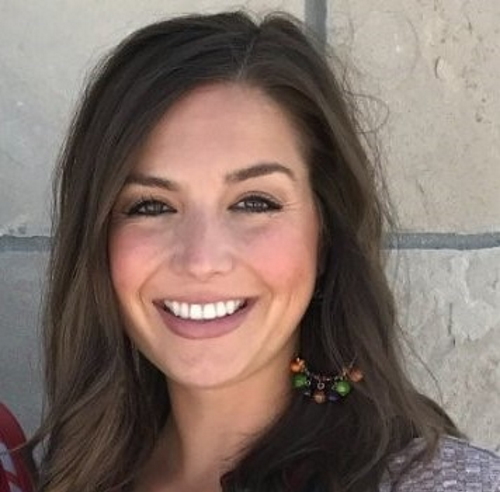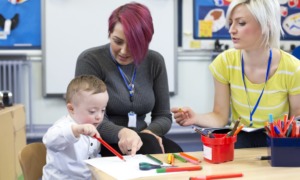
Who are youth with intellectual and developmental disabilities (IDD)?
The population of youth with IDD is vast. In 2018-19, the number of students ages 3–21 who received special education services under the Individuals with Disabilities Education Act (IDEA) was 7.1 million or 14% of all public school students. You may know some better-known IDDs such as autism spectrum disorder (ASD), fetal alcohol spectrum disorder (FASD), Down syndrome and cerebral palsy, to name a few.
 What you may not know is that many youth with IDDs may have behavioral challenges associated with their disability due to communication barriers, which in turn may evolve into behavioral problems such as property destruction, harm to themselves, harm to others or elopement. However, often the student with IDD behavior serves a purpose and is most likely functional.
What you may not know is that many youth with IDDs may have behavioral challenges associated with their disability due to communication barriers, which in turn may evolve into behavioral problems such as property destruction, harm to themselves, harm to others or elopement. However, often the student with IDD behavior serves a purpose and is most likely functional.
For example, consider someone with ASD. Environmental conditions can set up, set off or maintain appropriate or inappropriate behavior for a student. An overstimulating environment such as loud noises, bullying or a break in routine may cause that youth with IDD to engage in aggressive behavior because he/she may not be able to communicate what is bothering him/her. When such behavior is too challenging to manage, the school may take unfortunate steps that push that student out of school and into the juvenile justice system.
Defining the problem

Darla Stuart
The special education “school-to-prison pipeline” refers to policies and practices that disproportionately push children with disabilities out of classrooms and into the juvenile criminal justice system. Consider this: Students with disabilities comprise less than 12% of high school students nationwide, but represent 75% of students restrained, 58% of students who are secluded and more than 13% of students subject to out-of-school suspension. Additionally, students with disabilities who are eligible for IDEA represent 25% of students arrested and referred to law enforcement, even though they only represent 12% of the overall student population.
Most detained youth have special education needs
The prevalence of youth with disabilities in juvenile corrections is three to five times greater than youth with disabilities in public schools as 85% of youth in juvenile detention facilities have special education qualifying disabilities. Sadly, only 37% of youth in detention facilities who needed special education actually received the support they needed through IDEA.
Special education is a federal and state entitlement; IDEA governs how special education is federally mandated. To be eligible for IDEA, a child must have a qualifying disability plus the need for special education and related services because of that disability. IDEA covers 13 disability categories, including deafness, blindness and emotional, physical and developmental disabilities. In most states, children are eligible for IDEA at age 5 and can receive special education through age 22. Students who qualify under IDEA are provided an individual educational plan (IEP).
Why does an IEP matter?

Erica Dennison
An IEP is a federally mandated document that provides students with disabilities the right to free appropriate public education (FAPE) within the least restrictive environment (LRE). An IEP is a contractual relationship between the student, family and school. It maps out the program of instruction, supports (including behavioral) and services the child needs to make progress and thrive in school.
If there are behavioral challenges, these could be signs that the school did not create and/or implement the IEP correctly. If a child with an IEP has a disciplinary removal from the class (suspension, expulsion or the contacting of law enforcement) and that behavior is a manifestation of the student’s disability, then the IEP needs to be revised to include behavior analysis and a subsequent behavior plan. A failure to provide such behavioral supports to a child, depending on the circumstances, could constitute a denial of FAPE, which is a foundation of IDEA.
Never too late
Youth with disabilities involved in the juvenile justice system are still guaranteed entitlements under IDEA, including an IEP and behavioral supports. If a student ends up in the juvenile justice system, push back. Encourage the school to support the child and his/her behaviors properly. Know that it is never too late to request an evaluation for an undiagnosed IDEA-qualifying disability that may affect a youth’s behavior and educational success, regardless of whether they are in the community or a youth corrections program. You can help keep youth with IDDs out of the juvenile justice system by being inquisitive, speaking up and transforming that youth’s life for the better.
Darla Stuart, executive director, has been involved with The Arc for more than 30 years. Throughout her tenure at The Arc of Aurora she has led local, state, regional and national projects improving the lives of people with developmental disabilities.
Erica Dennison, special projects’ and THINK+change manager with The Arc of Aurora, is a 2006 graduate from the University of Northern Colorado. Her career in the intellectual and developmental disability (I/DD) field spans nearly 17 years working a variety of roles throughout Colorado.





























